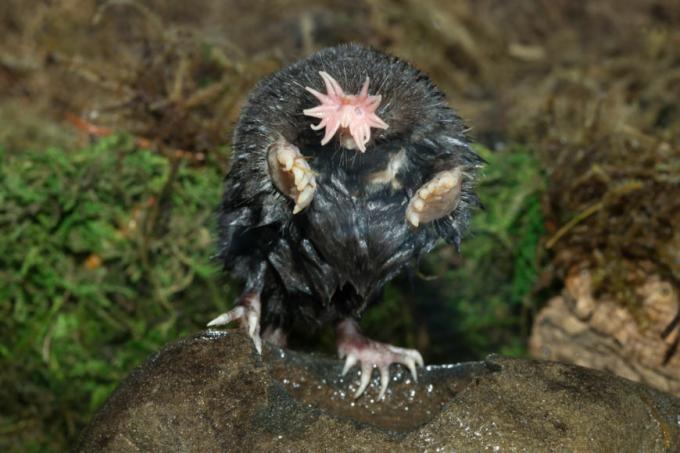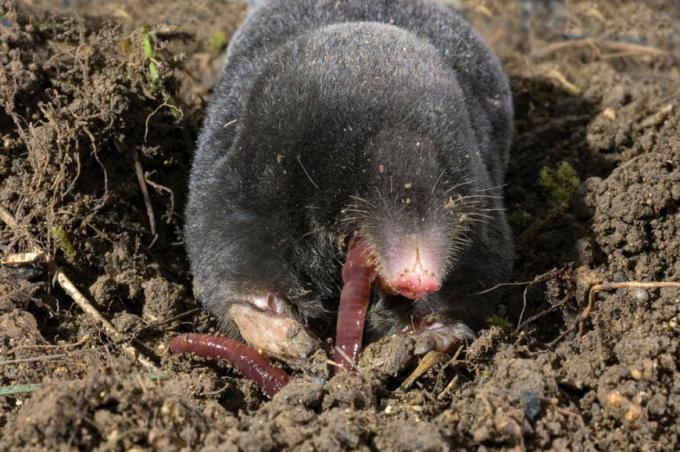Mole is the popular name given to some species of mammals of the Talpidae family. Although some species from other families are called moles because of their similarity to them, they are not considered true moles. Moles have a fossorial habit, that is, they are able to live under the ground, where they dig tunnels several kilometers long.
For digging, they rely on strong limbs with large claws. Those animals they have a cylindrical body and small eyes that, in some species, are covered by skin. Moles generally feed on invertebrate animals, like earthworms.
Read too: Salamander — another animal with a fossorial habit
mole summary
Moles is the name given to some species of mammals of the Talpidae family.
They are capable of digging underground tunnels.
They have a cylindrical body and forelimbs that facilitate the digging action.
They are not rodents, but some rodents are classified as such, despite not being considered true moles.
They have small eyes that, in some species, are covered by fur.
They feed mainly on invertebrates such as earthworms.
mole characteristics
Mole is the name given to some species of mammals belonging to the Talpidae family. These animals have cylindrical body and covered with velvety hairs. Moles are known for fossorial habit, having specializations that guarantee their survival underground.
Among these specializations, there is the presence of short, strong forelimbs with large claws, which are positioned so that the palms of the paws are facing backwards, thus helping in the excavation. Furthermore, they present diminutive eyes and absence of external ears.
mole species
There are several species of mole. Let's look at some below.
→ Star-nosed mole
The star-nosed mole (Condylura cristata) is one of the most curious species of moles. It is the only living species of the genus condylura, is native to North America and can be seen in different inhabitst, generally preferring moist soil areas.
It is a fossorial species that can build tunnels several meters long. It is worth noting that the tunnels can open into streams or lakes, and the species is considered semiaquatic. The star-nosed mole features a hairless nose and surrounded by 22 pink tentacles. These tentacles prevent soil from entering your nose as you dig your tunnels.
In addition, they are used to recognize the environment and prey due to the presence of very efficient tactile receptors. The tentacles are extremely sensitive, allowing prey identification after touch to be done in less than half a second.

The star-nosed mole weighs between 35 g and 75 g, and its size varies between 17.5 cm and 20.5 cm in length. The tail is 6.5 cm to 8.5 cm. The coat is short and varies in color from dark brown to black.
Females have eight breasts, and males have large testes, which can account for more than 8% of the total body weight during the breeding season. Gestation time is about 45 days, and females give à light of twoTheseven puppies, being more frequent the litter with five puppies. Puppies are born hairless and with eyes and ears closed. The tentacles around the nose are bent backwards.
→ European mole
The European mole (talpa europaea), as the name suggests, takes place in Europe andstands out for spending its entire life underground, forming an extensive network of tunnels, several kilometers long. In times of drought and low temperature, she uses the deepest tunnels.
European moles weigh between 72 g and 128 g and their length varies between 11.3 cm and 15.9 cm. The tail has a length of 2.5 cm to 4.0 cm. Males are slightly larger than females. The coat is black and the nose is hairless.
European moles are solitary, with the exception of the reproductive period. In this kind of mole, gestation lasts four weeks, with each litter counting on two to seven puppies. Puppies are born hairless and blind.
mole feeding

Moles feed mainly on invertebrate animals. In moles with a fossorial habit, it is common to observe the ingestion, for example, of earthworms present in their tunnels. In the case of the star-nosed mole, which also has access to the aquatic environment, it is common to observe predation by species such as:
leeches;
larvae of insects;
crustaceans aquatic;
clams.
Is the mole a rodent?
The term mole is more correctly used to refer to some representatives of the Talpidae family, which is part of the order Soricomorpha. As they are not part of the Rodentia order, moles rodents are not considered.
It is worth noting, however, that TheSome other species of animals are also called moles., like the naked mole rat (Heterocephalus glaber). This rodent, however, is not considered a true mole, as it does not belong to the Talpidae family.
See too: Capybara — the largest rodent in the world
Is the mole blind?
Moles are practically blind animals. In the different species, the eyes are quite small and, in some cases, covered by fur. In the star-nosed mole, for example, the eyes are visible, however, they are only used to identify light and dark.



